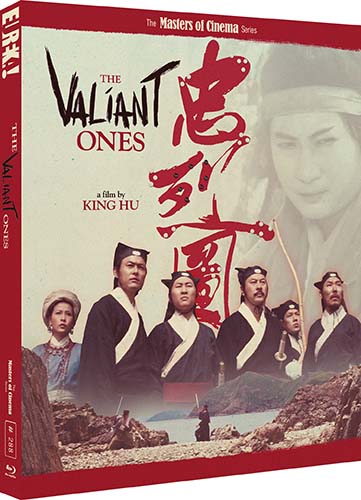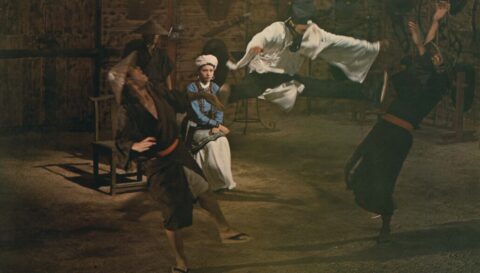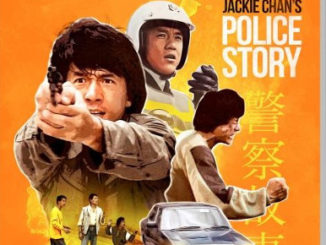The Valiant Ones (1975)
Directed by: King Hu
Written by: King Hu
Starring: Bai Ying, Hsu Feng, Roy Chiao, Wu Chia-Hsiang
AKA ZHONG LIE TU
HONG KONG / TAIWAN
AVAILABLE ON 4K ULTRA HD AND BLU-RAY: NOW, from EUREKA ENTERTAINMENT
RUNNING TIME: 102 mins
REVIEWED BY: Dr Lenera

Pirates are have causing havoc in China for centuries, but it’s now become ridiculous and the ineffectual Emperpor Jia-jing doesn’t seem to be doing much about it. He puts loyal official Zhu Wan is put in charge of the problem, and Zhu recruits a skilled strategist named Yu Da-you to do the job. Yu sends word to a few worthy fighters to join him, most notably legendary swordsman “Whirlwind” Wu Ji-yuan and his wife Wu Ro-shi. The group have their work cut out for them, the pirates having spies all over the place and even some Chinese under their control….

I guess there are two main ways of filming fight sequences, especially those of a martial arts kind. You can just plonk the camera down and observe what’s going on, something which relies very much on the skills of the performers to excite the viewer. Or you can enhance the action using tight cutting [the early James Bond movies had editor Peter Hunt actually remove certain frames which would normally have been there to make brawls more exciting], which is very useful if your performers don’t have much or any martial arts expertise, though it’s something which has often gone overboard in the two or three decades in Hollywood and often resulted in an incoherent mess. I generally prefer the former, but there’s definitely something very aesthetically pleasing about the latter when it’s at its best, especially in Wuxia films when people often have to leap about in superhuman fashion. Hu was the first filmmaker to really try this style, then moved it forward and perfected it in The Valiant Ones, even though of course it doesn’t seem so fast nowadays considering what we’ve become used to. It was filmed back to back with The Fate Of Lee Khan, with a lot of that film’s cast, and I think it may be Hu’s best film after A Touch Of Zen, even if it’s essentially a series of fight sequences in beautifully photographed natural surroundings – but it makes the very best of its simplicity, and this simplicity could be a great thing to get people to see this who think that Hu, despite his importance and influence, is a bit too pretentious and too artsy for their tastes, even though I’d personally consider only two of his films to be worthy of being considered that, and such descriptions shouldn’t always be considered flaws anyway. It’s just full-on fun and excitement and presented in a meticulous way with lots of pictorially stunning tableaux, and even manages to override what at first seems a flaw; the lack of characterisation.
“King Hu Productions”, “King Hu” and the title appear as calligraphy on white pieces of paper against brown background, followed by some beautiful shots of the lake around where the action is going to take place. A narrator sets the scene well, giving us a good amount of information without rabbiting on. It’s the time of the Ming Emperor Jia-jing, and the country is weak. A long time ago gangs of Japanese Ronin teamed up with Chinese bandits to form a group of pirates called Wokou, and their raping and pillaging is now at an all-time worst. Their three leaders Hakatatsu, Xu Dong and Siamon, as well as some other real-life characters, are neatly introduced with cuts from paintings of these people to shots of them in the movie. These pirates have defeated several armies and the Emperor asks his magistrate about what’s being done about it. In fact Deputy General Zhu Wan submitted a proposal two days ago but the Emperor, not really seeming to be bothered, hasn’t even read it. “If it looks good to you, then tell him to proceed” he tells him. Captain Zhou Lide says there’s nothing to be afraid of and guarantees the safety of Shinan’s Chief who’s currently being escorted somewhere, but then, in the first of several humorous edits, we cut to lots of dead bodies by a banner that says “Shinan’s Chief “. Zhu tells the magistrate that Yu Da-you, “the Colonel of Zhangzhou”, whom he knew as a child, “is an excellent strategist”, though the magistrate considers him to be “pompous and arrogant”. Hu then uncharacteristically speeds through the next portion, dispensing with details and instead cutting to the already recruited Yu saying to somebody else “have you reached out to everyone like I asked”, as a few men and a women gather in a country house.
Some may find it not too easy to totally get into matters, because only two of the recruits – husband and wife Wu Ji-yuan and Wu Ro-shi – are given any kind of prominence and don’t seem to exhibit much of the way of characterisation, while the others aren’t even always distinguishable. In other films Hu would introduce people by the way they’d do certain things, but here they barely get introductions, except for a guy constantly playing the flute. “Keep playing the flute and the Wokou will be here” . People don’t even interact with each other much. This was a deliberate decision by Hu who scripted as well as directed, and who was obviously trying to avoid cliche. It works if you let it and are open to picking up on tiny details. The elderly owner of the house warns of spies in the village and even the magistrate’s office, and sure enough the house is soon surrounded by men with swords and bows and arrows. One warrior pulls out his sword and sets about them, while others catch arrows that are being fired, and even the owner helps by throwing his fishing net over a guy trying to flee, then refuses money from Yu to buy a new one. The group then goes into the forest and Yu returns to the court where Zhu tells him that he should clear the roadways first, but Yu says no, it’s much better to dress up as merchants and lure the pirates out. Capturing some Japanese leads Yu, who doesn’t believe in torturing them when they won’t talk, to think of a cunning plan; let the captives hear about some treasure being transported, let them escape by staging a fake fight where a knife is dropped, and therefore spread the information among the Japanese. There are tactics and counter-tactics, won skirmishes and lost skirmishes, trickery and treachery because, as Yu rightly says, “in war, nothing is too deceitful”. It’s all easy to follow, while Ro-shi eventually gets one very revealing moment where out of modesty he doesn’t show an admiring fan some moves, preferring to teach him some Chi instead – only for some bad guys to suddenly attack so that he has to show off his stuff anyway!

The bad guys attack and attack, there seems to be an inexhaustible supply of them, often in uniform but not always. Sometimes they’re seen from a distance, on some cases quick enough for the guy with the telescope or the guy who plays the flute to warn the others, on other occasions they just sneak up on them or jump out of the trees. The fights, choreographed by Ng Ming-choi and Sammo Hung. are mostly with weapons, and usually swords – none of those fancy weapons you see in many Shaw Brothers movies. Sometimes we only see the aftermath. Any monotony is prevented by the varied outdoor locales [only the first one partly takes place indoors] and the stunning cinematography of Chris Cheng. Bai Ying is involved in most of them, and he doesn’t look like he was actually a martial artist judging by what we see, but the cutting and the pictorial skill, with lots of precise compositions, make up for this. Cheng likes to have jump cuts and remove certain shots that you may expect, to suggest speed, and have tracking shots going left followed by tracking shots going right during fights. There’s a sequence just before the climax which feels like padding yet will delight Hong Kong cinema fans where the Wu’s are in the Woudo headquarters and are challenged by a series of folk, some of them future stars whom I won’t mention to maintain the surprise. The encounters are brief but have some great funny touches. The climactic battle is a bit more bloody than we usually get from Hu, and, while it’s hard to take total non-martial artist and often-shot-from-the-back Roy Chiao as Yu when he’s fighting the Big Boss himself Yin-Chieh Han in the woods, the final conflict where, after doing nothing all throughout the film except to look on menacingly in on scene, Hung, in creepy white face paint comes forth to take on Ying on a beach, is definitely Hu’s best one-on-one fight as well as his longest. In fact, it might be the greatest fight ever done which emphasises a variety of cinematic techniques over pure skill.
It’s a shame that Hu’s favourite actress Tsu Feng is largely wasted in his particular film; her character being almost entirely in the shadow of her husband and only getting a few seconds of dispatching baddies. But we get Hu’s favourite theme of sacrifice for the common good, as well as some jabs at high-ranking types. The Emperor has no interest in problems and just leaves decisions to his subordinates. He doesn’t even know the rank of somebody very prominent. Meanwhile Captain Zhou rubbishes claims that the pirates are dangerous, then foolishly ventures into the wilderness on his own. As he says to Yu, “I wanted to see if your trick worked, who would have thought I’d run into them here”? At one point the humour gets low enough to laugh at diarrhea, though it’s generally more pointed than that and not that very prevalent anyway. Scenes of jumping into the air and arrow dodging and throwing back at their senders perhaps jar with the mostly realistic approach, this being probably the most realistic of all of Hu’s films, though then again it does contain a wonderful device where, as the enemy closes in from all directions, Yu plots the battlefield out on a Go [Chinese strategy game] board. Without words, we get a scale of the threat but also learn how the good guys are plotting to get out of it. And these are the “good guys”, yet, unlike in most genre films of the time, the Woudo aren’t depicted like the way they’re described at the beginning, as people who “raped, looted, torched, and killed”. There were plenty of opportunities to show the Japanese, especially, as typically evil, which so many films of the time did, but they’re ignored.
Wang Yun-Dong’s busy modern classical style music doesn’t always work well with what’s taking place on screen, though some traditional percussion fits much better. It certainly doesn’t detract from the tremendous enjoyment value of this often simple but very elegant and in the end rather sad last hurrah, full of care and attention to detail which is what distinguishes the films of Hu from his contemporaries, for the traditional Wuxia film which then went dormant for some time. It may have influenced one of Jackie Chan’s very best, Project A.
SPECIAL FEATURES
Limited edition O-Card slipcase featuring new artwork by Grégory Sacré (Gokaiju) [2000 copies]
1080p HD presentation on Blu-ray from a 4K digital restoration of the original negatives gifted by director King Hu to the Hong Kong Film Archive
Another very fine restoration. Great colour, even grain, precise detail – the film not looking its age yet still seeming like it looks the way it should
Uncompressed original Mandarin mono restored from the original soundtrack negative
Optional English subtitles newly translated for this release
Brand new audio commentary by Asian film expert Frank Djeng (NY Asian Film Festival)
Djeng provides an especially excellent commentary here. He clearly loves and understands Hu’s work and listening to him really makes you realise how thought out and precise this film is, from placement of characters in shots to people’s hats to everyone being introduced in descending order of power. We also learn that it was lost until 1996 when a copy was found in a film lab, plus how much it follows historical events. People even speak in an accurate antiquated fashion, something which wouldn’t be picked up by most non-Chinse viewers. Djeng’s ability to race through biographies and prune them down should be a model for others to follow. This is top grade stuff indeed.
Tony Rayns on “The Valiant Ones” – Brand new interview with critic and Asian film expert Tony Rayns [26 mins]
Rayns, a huge admirer of Hu, to the point of always mentioning him if an opportunity allows it, is obviously the right person to discuss The Valiant Ones, but commendably avoids going into huge detail about Hu’s career which he’s done before. He sees the film as being even more different than I thought, viewing it as being influenced by the Cultural Revolution, tells us that it’s Hu’s calligraphy that we see at the beginning, and translates the Chinese title as Portrait Of The Loyal Martyrs.
Tsar of all the Wuxia – a new video essay by David Cairns [21 mins]
Cairns’ track in some ways is similar to Rayns’, certainly covering similar ground, though Cairns gives us a longer leadup to discussing The Valiant Ones, with some really interesting clips, not to mention the fact that the 1934 The Burning Of The Red Temple could be the longest film ever made, lasting 27 hours! Cairns then says little about the cast, preferring to go into the filming style, aided by quotes from others in describing Hu’s technique and effect. We also learn that one scene of Ying moving quickly was achieved by the use of a double.
The Life of a Lucky Stuntman – Brand new interview with stuntman Billy Chan [20 mins]
Chan chooses not to go into detail about his rough time at a martial arts school which would be classed as child abuse today, but gives interesting recollections about his time as a stuntman, from Frankie Chan claiming he knew the right moves for a fight but becoming really bruised and weak, to Hu sketching action scenes with precision. Indeed Hu’s precision in general is well described, notably of course a set for A Touch Of Zen which looked too new – so Hu left it for a year, then went back to it and used it.
My Father and I – Brand new interview with actor Ng Ming-choi [29 mins]
As well as co-choreographing the action with Hung, Ng did lots of other jobs, something that was common on a Hong Kong movie set, in addition to playing the flute player. His comments on Hu, such as him having lots of books in every room in his house, are perhaps unsurprising, but he also says how Hu tended to oversee the action and not just leave it to the fight choreographer like many other directors, and how production stopped twice so Hu could earn some money lecturing and provide funding which had ran out; the climax had to utilise another actor because the original one couldn’t return!
Memories of Hu – Archival 2003 interview with Roger Garcia (Hong Kong International Film Festival Society) by Frédéric Ambroisine [24 mins]
Garcia spent some time with Hu in the late ’70s during tbe shoot in Korea for Raining In The Mountain and Legend In The Mountain, and this 2003 interview reveals some interesting stuff about the filmmaker who he says “was not the easiest of men to work with”, such as him wanting to make an animated film called The Boiling Sea which he died before he could set up, not to mention other planned projects including even a modern-set film taking place in California! It also seems that Hu wanted to make projects which were too ambitious for the resources that were available to hum, something not helped by the commercial failure of A Touch Of Zen.
Archival 2003 interview with actress Hsu Feng by Frédéric Ambroisine [16 mins]
The still extremely pretty Feng answer questions until one of the microphones is cut off, whereupon the sound was bad so a lot of questions were skipped. Most interesting were Feng’ s reason for producing – she said she may not act anymore as she’s married but was told should still contribute to China – Hu telling her to act in her head “the audience will understand you through your eyes”, and that she wants to remake A Touch Of Zen – ummm, no thank you, let’s hope that she never finds “the right director”.
Archival 2016 interview with actor Ng Ming-choi by Frédéric Ambroisine [4 mins]
This is disappointingly brief, but it’s great to here of Ng talking of Hu’s perfectionism again, as well as Li Han-hsiang drinking cognac and Hu drinking coffee!
A collector’s booklet featuring new writing on the film by Jonathan Clements
“The Valiant Ones” is an almost delirious blend of action entertainment and precise artistry. Eureka Entertainment’s release is a fitting tribute to this neglected high point of martial arts cinema – even if actual fighting skill is minimised. Highly Recommended!







Be the first to comment